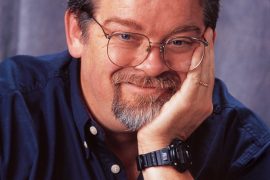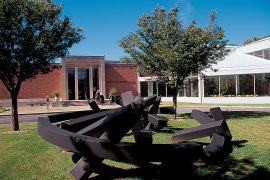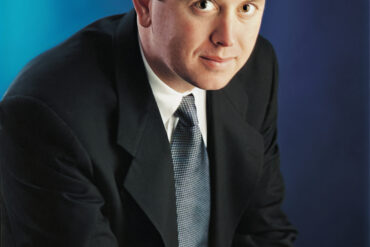Like a fine wine, HQ only gets better with time.
By Kevin Savage
HQ 53 | AUTUMN 2004
Since its inception in 1989, Huntington Quarterly has kept an elegant hand firmly on the pulse of the great city of Huntington, West Virginia, chronicling the many positive changes in our community.
Who better to discuss the parallel changes and growth of the city and the magazine than its founder and publisher, Jack Houvouras. Throughout this anniversary celebration, we’ll look back through his eyes. We’ll also reflect on the premier issue of the magazine and note some of the changes since then. Some reminisces will be comical, some poignant, but just like the publication, all will be entertaining.Like a fine wine, the magazine has evolved and only gotten better with time. The one constant is the quality, accuracy and commitment to excellence in serving readers with interesting articles, beautiful photography and classic design.
In the Huntington Quarterly’s first ever editorial, Houvouras announced his intentions for the new publication: “First, I wanted to entertain and inform local readers. Second, I hoped to use the magazine as a means to promote the city,” he wrote.
“I think I’ve fulfilled just about all my goals,” Houvouras said recently. “I started this publication for one reason: to give the people of this region a reason to feel proud about living here. Fifteen years later, I think we’ve accomplished that.”
Houvouras said he’s heard comments such as: “You make Huntington look a lot better than it really is” and “I wish Huntington looked as good as it does in your magazine.”
“I don’t know if those are fair things to say, but I do think we try to show the very best of what Huntington has to offer,” Houvouras explained. “That was my original goal, and I think we’ve accomplished that over the years.
“I enjoy telling the story – because I’ve always liked the underdog – of how people predicted the magazine wouldn’t last a year. After we had our one year anniversary, they told me it wouldn’t last two. Then it was five. Then it was 10.”
Houvouras explains how commitment to quality and excellence has opened doors to other business opportunities. “Marshall University contacted us five years ago and said, ‘We want to publish a magazine for our alumni. We’d like you to do it because your product is so good.”
What followed was the Marshall Magazine, a publication with all the quality of its parent publication, and content as relevant and cutting-edge as the university it represents.
“We’ve had a wonderful relationship with Marshall University since then,” Houvouras says, “and it’s really helped us grow and prosper.”
Another publication that has sprung from the success of Huntington Quarterly is St. Mary’s Today, the official magazine of St. Mary’s Medical Center.
“We approached St. Mary’s in 2002 and they wanted to start a publication for the same reasons as Marshall University. They wanted to be associated with a quality product like the Huntington Quarterly.”

St. Mary’s Today magazine was recently recognized at the Aster Awards – a national medical marketing program dedicated to excellence in medical advertising. The magazine received a Gold Award in the category of magazine publication. The magazine competed against more than 1,700 entrants from across the nation.
H.Q. Publishing Co., the parent company of all three magazines, has also been the source of the Huntington Regional Chamber of Commerce Directory & Lifestyles Magazine for the last two years. This relationship has broadened the base of local talent the magazine can utilize. Articles about Huntington may be accessed along with archived photos of the area.
Because of the obvious quality of his products, Houvouras says he is now approached at least a couple times a year by some individual or organization wishing to publish a book or magazine.
Looking back 15 years to the premier issue of the magazine, Houvouras reflects on some of the things that have and haven’t changed.
The first story ever published in Huntington Quarterly was “The Two Lives of A. Michael Perry,” about the accomplished businessman and civic leader who was then C.E.O. of Key Centurion Bancshares. For all his success as an attorney and banker, his greatest love, other than his wife Henriella and family, was his 200-acre farm in rural Wayne County.
When the magazine premiered 15 years ago, the humble farm with one restored log cabin has evolved into Heritage Farm Village & Museum, a veritable Appalachian town of yesteryear comprising more than 15 individual buildings and dwellings, many available for overnight stays. The mission of Heritage Farm, according to Perry, is to preserve our Appalachian heritage and to show the world that it is something of which to be proud. Additionally, the Farm represents how far our ancestors have come and inspires us to continue that journey.
The first homes feature showcased “Contemporary Camelot,” a sprawling, contemporary mansion owned by Dr. and Mrs. Craig Morgan. The impressive home perched high above the city on Camelot Drive featured four levels, 15 rooms, and even an indoor racquetball court and swimming pool. Houvouras says the “Homes” section is the most popular in the publication, and HQ continues to showcase a unique home in each edition.
The “Yesterday” feature in the premiere issue was about Sen. John F. Kennedy’s visit to Huntington in 1960. The young candidate faced a tough crowd as a Catholic Democratic hopeful in a state comprised of only a 4.5 percent Catholic population. Kennedy’s visit, like his presidency, was an overwhelming success. He went on to win the hearts and votes of the state of West Virginia and, as he promised, never forgot his friends in the Mountain State.
Today, presidents and presidential hopefuls are still coming to West Virginia and Huntington. George W. Bush and John Kerry both made stops in Huntington and the Mountain State an essential part of the 2004 presidential campaign.
The “Tomorrow” section of the first issue contained a story anticipating the success of the Huntington Main Street Program. After those plans failed to materialize, along with sustained disappointing efforts to develop the “Superblock,” optimism is once again riding high with the opening of Pullman Square, the grand-scale shopping and entertainment complex.
“The Fall and Rise of Marshall Football” was a story in the first issue chronicling the tragedy and later success of Thundering Herd program. Looking back only 15 years brings the tremendous accomplishments of the program into brilliant focus.
“When we did our first issue 15 years ago,” Houvouras says, “we showed an artist’s rendering of Marshall Stadium. George Chaump was the coach, and we were a NCAA Division I-AA program. We’ve since built a new stadium, won two I-AA national championships and moved up to Division I-A where we’re not just playing with the powerhouse schools, but really competing. Just ask the players at Ohio State and Georgia. The program continues to rise.”
The travel section continues to be a popular segment of the magazine. The first destination featured was the Cass Scenic Railroad, where visitors may still ride an authentic Shay steam engine to the summit of Bald Knob in Pocahontas County.
Houvouras explains why there’s still a travel piece in each issue: “We think West Virginia is one of the greatest states in which to live because of the tourism opportunities and the natural beauty that abounds. We try to profile different places throughout the state for our readers to visit.”

The spring 2004 edition of Huntington Quarterly, for example, featured a cover story entitled “99 Things Every West Virginian Should Do,” which offered readers a cornucopia of travel and adventure throughout the Mountain State.
That issue recently won an award for its excellence in photography and design presented by the West Virginia Division of Tourism.
Concerning changes in the publication itself over the past 15 years, technology has proven to be the greatest factor. Photographs, Houvouras says, are no longer taken on film. “Film is gone. All of our photography is digital, so what you see on the computer screen is what comes off the press.”
And the computer screens have definitely changed. “When we started this magazine I had one MacIntosh computer with a nine-inch black and white monitor. Now we have four different computers, all with 20-inch monitors.” And that’s not all.
“We’ve got color printers, back-up systems, scanners, drawers full of CDs with photos of the Huntington area, plus file upon file of color slides. It’s a far cry from the little computer with the nine-inch monitor.”
Huntington native David E. Fattaleh is still the magazine’s Photo Editor.
“One big reason people love our magazine,” Houvouras says, “is because of his outstanding photography.” Indeed, when Fattaleh began working for the publication he had already been a nationally recognized professional photographer for 13 years and held the position of Photography Manager for the West Virginia Division of Tourism. He now incorporates his art into a History of West Virginia program for schoolchildren and conducts digital photography workshops throughout the state.
While the quality of writing has remained constant over the years, the bylines have not. Houvouras is grateful for the opportunity to have worked with many writers who have come and gone.
“People come to me looking to get started in the writing business and when they find that job and move on they use our magazine as an example of what they can do. I’m happy for them, but I hate to see them go because I lose great writers who go to different parts of the country looking for work.” The magazine has also given Houvouras the opportunity to meet and interview a lot of intriguing people over the years.
“I think it’s a wonderful luxury to have the opportunity to publish your own magazine and be able to pick and choose people you find interesting or admire, and then do a story from start to finish the way you want, in the way that you think is the most representative or respectful of them.”
This was especially true of the famed test pilot and West Virginia native Chuck Yeager.
“I’ve never been one of those people who becomes star struck,” Houvouras said. “I think it’s odd when people get flustered around celebrities or the president of the United States. But when I met Chuck Yeager, I was a little nervous. I was struggling to find words, and I’ve never had that happen before or since.”
Another interviewee of note for Houvouras was Paul Newman who graced the cover of the Winter 1993 edition.
“Newman came to Huntington in 1966 when he was preparing for the film Cool Hand Luke. He spent several days in town talking with people throughout region in an attempt to acquire an Appalachian accent for his role in the film, and my father was his guide.

“My parents and brothers and sisters all got to meet him, but because I was just a toddler at the time, I never did. I had always regretted that.”
So it was all the more satisfying when, to his surprise and initial disbelief, the ever cool and consummate Newman returned Houvouras’ call about doing an article on that historic visit to Huntington. What resulted was a cover story entitled, “When Paul Newman Came to Town,” which Houvouras said is still one of his favorite issues of all time. This, Houvouras reiterates, is the essence of what he likes best about the magazine.
“It’s very rewarding to be able to profile someone in the manner you think is appropriate. I get to do that with the writing, layout and photography – the way it’s supposed to be done, the way I think it should be done. Because they deserve something beyond the ordinary. That’s what I get to do with the magazine. That’s a real high for me.”
It’s that very vision of presenting a quality product, not just because the article subjects deserve something beyond the ordinary, but because the readers do as well, that has enabled HQ to survive these past 15 years.
Houvouras delivered on his promise to put Huntington in the best light possible, and the public responded in kind. It has been and continues to be a prosperous relationship for both the Huntington Quarterly staff and all the people who have ever called its namesake city home.
So, raise your glasses. Here’s to the next 15 years!





